Begonia leaf propagation
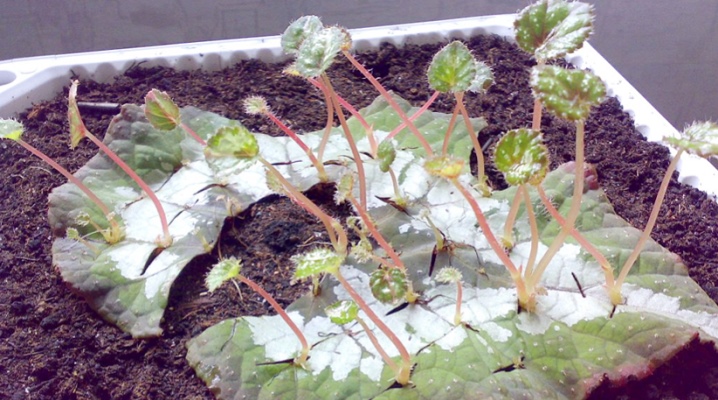
Begonias are perfect for decorating any room, balcony, patio. If you already have at least one healthy plant, it can be propagated quickly and successfully. Leaf propagation, due to its simplicity and efficiency, is considered one of the most popular. It is ideal for beginner indoor plant lovers.
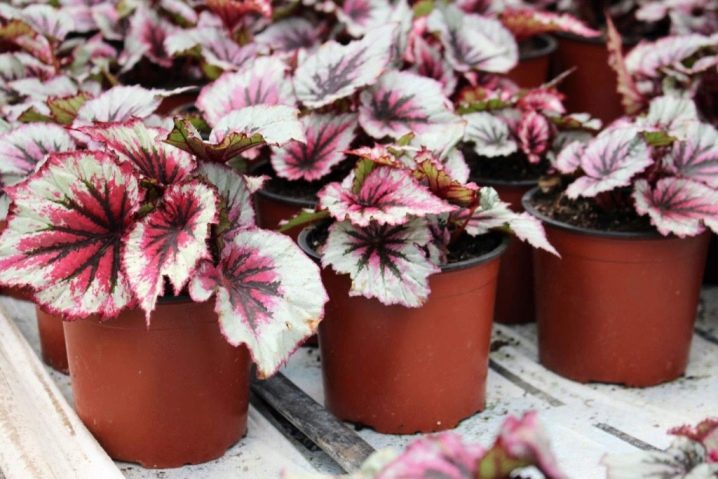
Peculiarities
At home, begonia propagates by cuttings, seeds, tubers. But it is leaf propagation that is used most often. This is due to the large number of positive characteristics.
- The loss of one leaf will not in any way affect the health and appearance of the plant.
- None of the stages requires special skills, effort and time.
- This method can be considered the most productive: after all, about 10 shoots can be obtained from one leaf plate.
- For some varieties of begonias, this reproduction option is practically the only one.
- Unlike seed propagation, you will know exactly what the future plant will look like.
- The planting material acts as a power source. Thanks to the beneficial substances that are in it, the shoots will grow faster than from seeds.
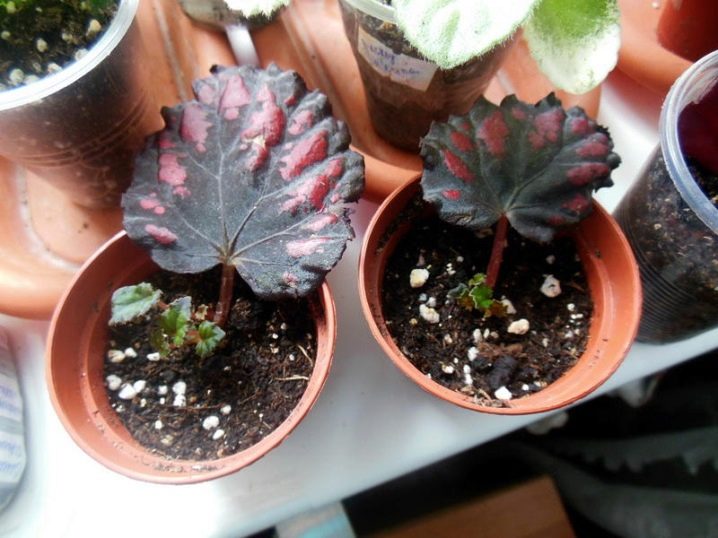
In addition, the sheet itself can be used in different ways:
- wait for the roots to appear by placing it in water;
- land in the ground.
In the latter option, you can use the whole plate or divide it into parts.

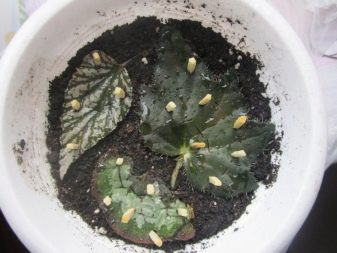
What needs to be prepared?
Preparation for breeding begonias is quite simple and does not require large expenses. To plant a leaf in any way, you do not need to specially buy any tools: you can do with improvised devices. You will need:
- priming;
- capacity for him;
- blade or sharp knife.
In order for the plant to take root faster and begin to develop, various stimulant fertilizers ("Kornevin", "Epin", "Energen") are often used. Using them is optional, but if reviews are to be believed, the results after use are pretty good.
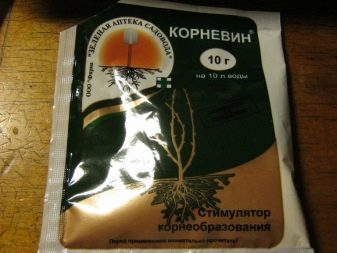
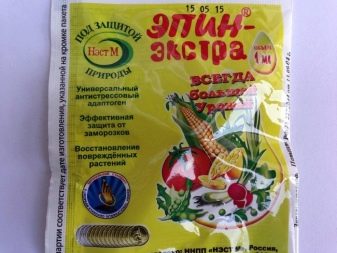
Almost any container is suitable at the initial stage. These can be new pots or used ones. Cups and household food containers can be used.
For the subsequent transplant, clay pots are better suited: air exchange processes run better in them, moisture evaporates. But for the first time, plastic is also suitable. For planting in parts of a leaf, you can take the smallest 100 ml containers.
All pots and other containers must be washed and disinfected with potassium permanganate or boiling water. It is advisable to boil used clay pots.
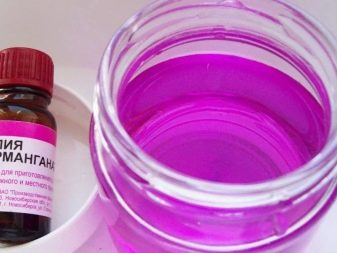

The choice of soil should be approached more responsibly. You can find the appropriate soil in the store: its composition is adapted for planting begonias, chrysanthemums and roses. And also the soil mixture is easy to prepare yourself.
- Take leafy soil, preferably from a forest or park (avoid willow and oak). It must be well cleaned, dried and sieved.
- The resulting mass should be mixed in equal proportions with peat and added 2 times less sand and humus. Thus, we get a moderately nutritious, slightly acidic, loose mixture.
- Before use, the mixture must be calcined to get rid of existing pests.
The bottom layer in the pot is usually drainage. You can buy expanded clay or use broken brick, pebbles and even foam.A little drainage needs to be added to the soil mixture itself: this way the moisture will be better distributed. All materials must be rinsed and dried.
For a better outflow of water in the bottom of the container, you need to make holes and pick up a pallet.
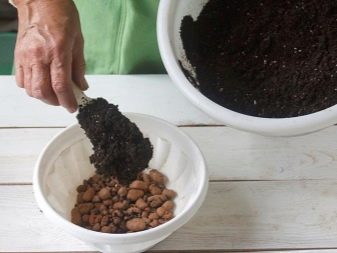
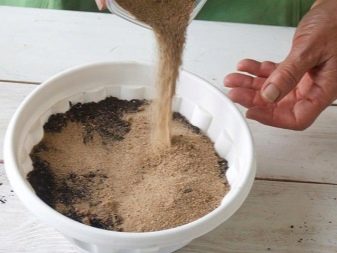
How to plant in the ground?
For this method, sheet plates are best suited, the seamy side of which is covered with fluff. The wider it is, the more seedlings you can get. It is necessary to choose one healthy leaf without stains and damage. It is better to carefully cut it off or cut it off with a knife: this way the parent plant is less injured. For landing, you need to step by step perform certain actions.
- Use a knife or razor blade to divide the sheet into several pieces. Tearing with your hands is undesirable. The division should take place in such a way that the large longitudinal veins are inside the segment.
- Each part must be placed in the ground separately. It is believed that they can simply be laid out on top of moistened soil.
- It will be much safer to plant them so that the cut of the vein is at the bottom, and the whole edge of the leaf is on top. The lower part of the leaf can be treated with a root growth stimulant.
- Then the containers need to be turned into a kind of greenhouse: cover with plastic on top and create partial shade. The film needs holes for ventilation. As it dries, the soil should be moistened, but it is better to use not watering, but spraying around each particle.
- The first shoots appear in 2 to 3 weeks. After that, the coating can be removed for a short time, increasing these gaps. Do not remove part of the old leaf at once: it can still give off some nutrients.
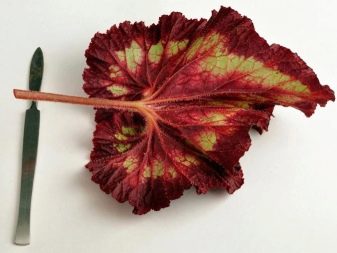

If this option seems too troublesome for you, it can be slightly simplified by using a common container.
- If the leaf has a small stem (stalk), you can plant it entirely. The leg must be cut obliquely and deepened a little, and slightly press the soil around. This method is used if a large number of shoots are not needed.
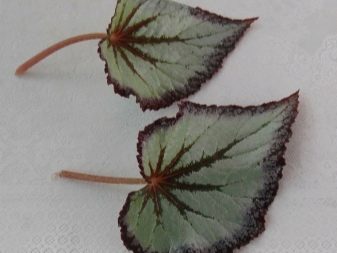
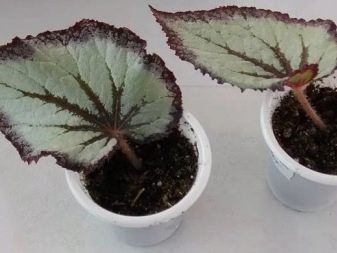
- The sheet can also be used in its entirety, but positioned horizontally. To increase the number of possible shoots, several cuts are made in it. It is better to put a couple of pebbles on top or along the edges: they will ensure a tight fit to the soil and protect against shifts. The sowing is covered with a film, moderate soil moisture is maintained. After the shoots get stronger, they can be carefully separated and planted.
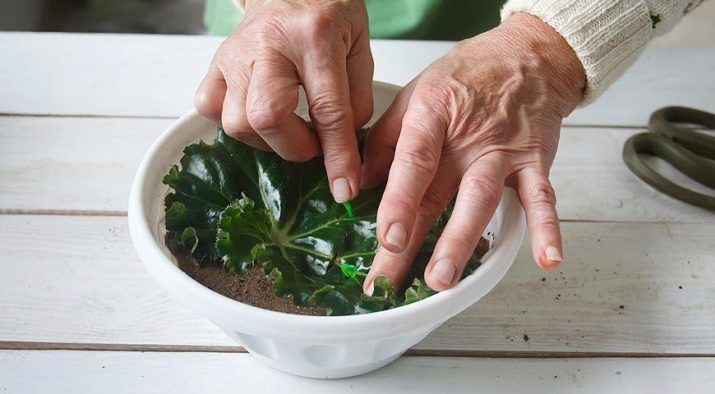
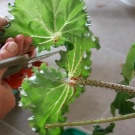
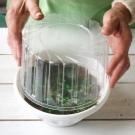
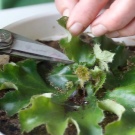
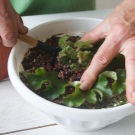
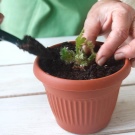
The condition of the seedlings should be closely monitored. If leaves appear, it means that roots sufficient for nutrition have appeared.
If the leaf remains in the same state for a long time, it may not have enough moisture. Excessive moisture usually ruins the plant: it changes color, rots, mold may appear. Growing plants need good lighting, so it is better to postpone reproduction until the spring. A couple of months after the shoots appear, larger pots can be prepared.

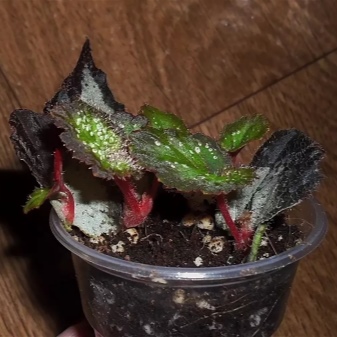
Rooting in water
Planting leaves without roots has one significant disadvantage: the lower part is hidden by the ground, and therefore it is not always possible to notice the appearance of rot in time. Usually, some of the seedlings die for this very reason. For reliability, you can root the leaf in water and after that place it in the ground: there will be more chances of success.
- You need clean boiled water cooled to room temperature. To speed up the process and disinfect it, you can add a little stimulant, charcoal or activated carbon to it.
- Pour the water into a suitable sized plastic or glass container. Place a leaf in it so that it does not fall through, and only its leg touches the water.
- It is better to cover the container on top with a transparent plastic cap, which can be made from a bottle or plastic bag.
- After the roots appear, the cap is removed completely, and a transplant into the ground can be planned.
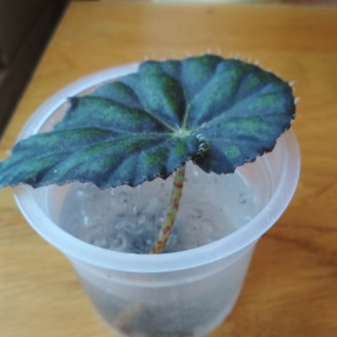
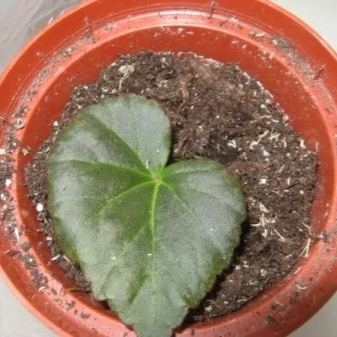
It usually takes up to 2 weeks to root in water. In dark glass, roots appear literally in a matter of days, but it makes diagnosis difficult. If, while in the water, signs of rotting appear on the roots or leaf, you need to urgently take action:
- wash the glass, boil and pour fresh water;
- remove all damaged areas from the seedling;
- sprinkle the slices with charcoal and air dry for a couple of hours.
If everything was done on time, the sheet will be saved.
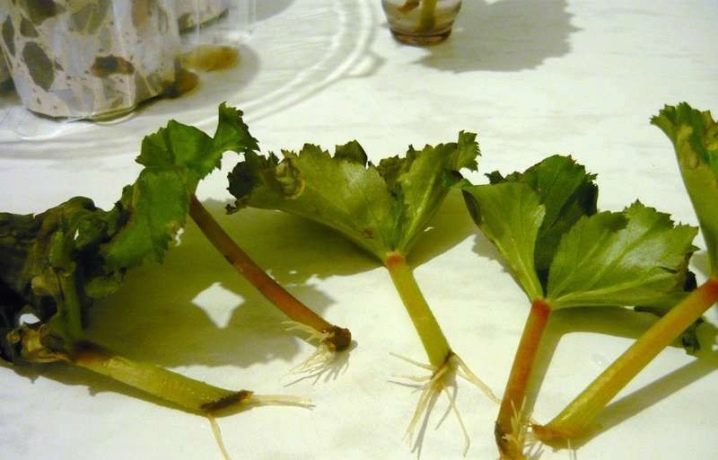
Follow-up care
To grow a beautiful begonia certain rules must be followed.
- The young plant should be kept away from sunlight and drafts. The same goes for the adaptation period after transplant.
- When the plant is strong enough, it can be moved to the sun and slowly hardened. Begonias are used in the design of balconies, and some species can be safely planted in flower beds.
- Since the historical homeland of begonias are tropical forests, humidity is important for them. In hot seasons, the pots can be placed on a common tray with pebbles and water. And you can also spray the air next to the plant and be sure to install a humidifier in the room.
- In the summer, watering should be fairly frequent: 2-3 times a week. The rest of the time, the soil is moistened as it dries.
- During the period of active growth of begonias, fertilizers are needed. They need to be made at least once a month.
- An adult plant is practically not transplanted. An exception may be diseases: rot, powdery mildew, bacterial diseases that appear as spots on the leaves. Plants are often attacked by pests. To detect diseases as early as possible, you need regular check-ups.
For information on how to plant a begonia with a leaf, see the video below.































The comment was sent successfully.